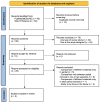Deep Carious Lesions Management with Stepwise, Selective, or Non-Selective Removal in Permanent Dentition: A Systematic Review of Randomized Clinical Trials
- PMID: 37628535
- PMCID: PMC10454894
- DOI: 10.3390/healthcare11162338
Deep Carious Lesions Management with Stepwise, Selective, or Non-Selective Removal in Permanent Dentition: A Systematic Review of Randomized Clinical Trials
Abstract
Objective: The goal of this systematic study was to investigate the effectiveness of selective, stepwise, and non-selective removal techniques for caries removal in permanent teeth with deep carious lesions. The primary focus was the results found comparing techniques for caries removal to check whether there was pulp exposition; the secondary was the materials used for pulp protection and clinical findings reported within the included studies.
Methods: The search was performed in two databases (PubMed/MEDLINE and Web Of Science). The studies included in this systematic review were selected based on eligibility criteria. The inclusion criteria were: (1) randomized controlled trials (RCTs), (2) that compared the total removal of carious tissue with selective removal in permanent teeth with deep carious lesions, (3) with a follow-up period of at least 6 months, and (4) publications in English. Regarding the exclusion criteria, the following were not considered: (1) articles published in other languages, (2) articles that did not compare the different types of total/selective decay removal, and (3) articles published before January 2008. The risk of bias and the quality of the included studies were independently assessed by two reviewers using the RoB 2 tool.
Results: 5 out of 105 potentially eligible studies were included. Regarding the teeth included in the study, three articles performed management only on permanent molars, while other studies also performed management on incisors/canines/premolars/molars. Management protocols were divided into nonselective caries removal and partial caries removal (selective/stepwise). The theory of non-selective caries removal was considered an excessive, unnecessarily invasive option and a form of outdated management, and selective removal was preferred.
Conclusion: The selective removal technique presented a higher success rate and fewer incidences of pulpal exposure than total removal, after up to 18 months of follow up. Moreover, only one session seemed to be a better management choice compared to two sessions because the cavity re-opening procedure is more prone to pulp exposure and highly depends on patient commitment. Otherwise, at 5 years of follow up, there was no difference between selective removal and total removal in management longevity. In addition, there were also no differences between the success of the materials used for definitive restorations in teeth subjected to any of the techniques evaluated.
Keywords: deep carious lesion; dental restoration; permanent teeth; pulpal exposure; selective removal; systematic review; total removal.
Conflict of interest statement
The authors declare that they have no competing interests.
Figures
Similar articles
-
Which caries removal method to select?Evid Based Dent. 2024 Mar;25(1):29-30. doi: 10.1038/s41432-024-00973-0. Epub 2024 Jan 22. Evid Based Dent. 2024. PMID: 38253747
-
Selective, stepwise, or nonselective removal of carious tissue: which technique offers lower risk for the treatment of dental caries in permanent teeth? A systematic review and meta-analysis.Clin Oral Investig. 2020 Feb;24(2):521-532. doi: 10.1007/s00784-019-03114-5. Epub 2019 Nov 26. Clin Oral Investig. 2020. PMID: 31773371
-
Partial caries removal may have advantages but limited evidence on restoration survival.Evid Based Dent. 2013 Sep;14(3):74-5. doi: 10.1038/sj.ebd.6400948. Evid Based Dent. 2013. PMID: 24071673
-
What is the best caries removal strategy for primary molars?Evid Based Dent. 2021 Jan;22(1):20-21. doi: 10.1038/s41432-021-0150-x. Evid Based Dent. 2021. PMID: 33772125
-
Caries removal strategies for deep carious lesions in primary teeth: Systematic review.Int J Paediatr Dent. 2020 Jul;30(4):392-404. doi: 10.1111/ipd.12616. Epub 2020 Feb 18. Int J Paediatr Dent. 2020. PMID: 31943437
Cited by
-
Effect of Liners on Pulpal Outcome After Partial Caries Removal in Permanent Teeth: A Systematic Review and Meta-Analysis.Cureus. 2025 Feb 10;17(2):e78831. doi: 10.7759/cureus.78831. eCollection 2025 Feb. Cureus. 2025. PMID: 40084310 Free PMC article. Review.
-
Evaluating Glass Ionomer Cement Longevity in the Primary and Permanent Teeth-An Umbrella Review.J Funct Biomater. 2024 Feb 19;15(2):48. doi: 10.3390/jfb15020048. J Funct Biomater. 2024. PMID: 38391901 Free PMC article. Review.
-
A Multi-National Questionnaire-Based Analysis of Dental Students' Knowledge of the Management of Deep Caries and the Exposed Pulp.Int Dent J. 2025 Aug;75(4):100844. doi: 10.1016/j.identj.2025.100844. Epub 2025 Jun 6. Int Dent J. 2025. PMID: 40482574 Free PMC article.
-
A Comprehensive Evaluation of Zirconia-Reinforced Glass Ionomer Cement's Effectiveness in Dental Caries: A Systematic Review and Network Meta-Analysis.Dent J (Basel). 2023 Sep 8;11(9):211. doi: 10.3390/dj11090211. Dent J (Basel). 2023. PMID: 37754331 Free PMC article. Review.
-
Assessment of Endocyn on Dental Pulp Stem Cells (DPSCs): A Pilot Study of Endodontic Irrigant Effects.Methods Protoc. 2025 Feb 11;8(1):18. doi: 10.3390/mps8010018. Methods Protoc. 2025. PMID: 39997642 Free PMC article.
References
-
- Clarkson J.E., Ramsay C.R., Ricketts D., Banerjee A., Deery C., Lamont T., Boyers D., Marshman Z., Goulao B., Banister K., et al. Selective Caries Removal in Permanent Teeth (SCRiPT) for the treatment of deep carious lesions: A randomised controlled clinical trial in primary care. BMC Oral Health. 2021;21:336. doi: 10.1186/s12903-021-01637-6. - DOI - PMC - PubMed
-
- Barros M.M.A.F., Rodrigues M.I.Q., Muniz F.W.M.G., Rodrigues L.K.A. Selective, stepwise, or nonselective removal of carious tissue: Which technique offers lower risk for the treatment of dental caries in permanent teeth? A systematic review and meta-analysis. Clin. Oral Investig. 2020;24:521–532. doi: 10.1007/s00784-019-03114-5. - DOI - PubMed
Publication types
Grants and funding
LinkOut - more resources
Full Text Sources
Medical



